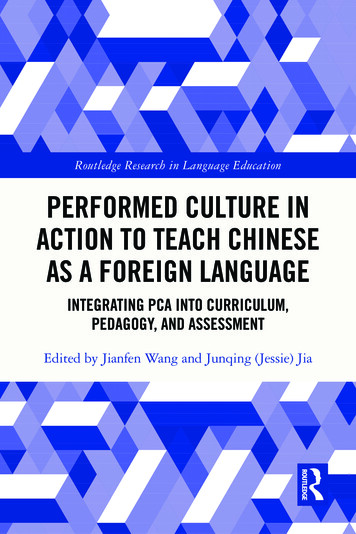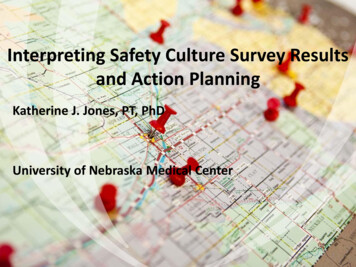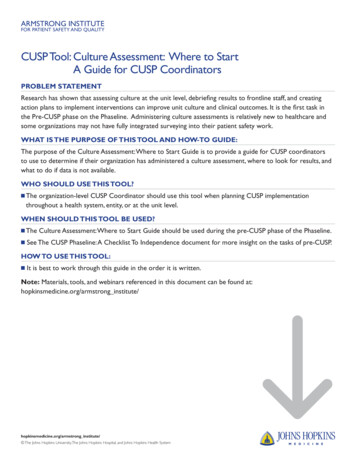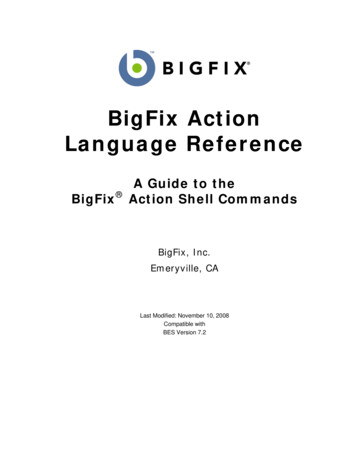
Transcription
Routledge Research in Language EducationPERFORMED CULTURE INACTION TO TEACH CHINESEAS A FOREIGN LANGUAGEINTEGRATING PCA INTO CURRICULUM,PEDAGOGY, AND ASSESSMENTEdited by Jianfen Wang and Junqing (Jessie) Jia
Performed Culture in Action to TeachChinese as a Foreign LanguageThis volume explores best practices in implementing the Performed CultureApproach (PCA) in teaching Chinese as a foreign language (CFL).Offering a range of chapters that demonstrate how PCA has been successfullyapplied to curriculum, instructional design, and assessment in CFL programsand classrooms at various levels, this text shows how PCA’s culture-focusedparadigm differs fundamentally from the general communicative languageteaching (CLT) framework and highlights how it can inspire innovative methods to better support learners’ ability to navigate target culture and overcomecommunication barriers. Additional applications of PCA in the developmentof learner identity, intercultural competence, autonomy, and motivation arealso considered.Bridging theoretical innovations and the practice of curriculum design andimplementation, this work will be of value to researchers, teacher trainers, andgraduate students interested in Chinese teaching and learning, especially thosewith an interest in incorporating performance into foreign language curriculums with the goal of integrating language and culture.Jianfen Wang is an Associate Professor of Chinese and Asian Studies at BereaCollege, Berea, KY, USA.Junqing (Jessie) Jia is an Assistant Professor of Chinese in the Departmentof East Asian Languages and Literatures at Hamilton College, Clinton, NY,USA.
Routledge Research in Language EducationThe Routledge Research in Language Education series provides a platform forestablished and emerging scholars to present their latest research and discusskey issues in Language Education. This series welcomes books on all areasof language teaching and learning, including but not limited to languageeducation policy and politics, multilingualism, literacy, L1, L2 or foreignlanguage acquisition, curriculum, classroom practice, pedagogy, teaching materials, and language teacher education and development. Books inthe series are not limited to the discussion of the teaching and learning ofEnglish only.Books in the series include:Complexity in Second Language Study EmotionsEmergent Sense-making in Social ContextRichard J. SampsonPerformed Culture in Action to Teach Chinese as a Foreign LanguageIntegrating PCA into Curriculum, Pedagogy, and AssessmentEdited by Jianfen Wang and Junqing (Jessie) JiaVirtual Exchange for Intercultural Language Learning and TeachingFostering Communication for the Digital AgeMartine Derivry and Anthippi PotoliaTechnology in Second Language WritingAdvances in Composing, Translation, Writing Pedagogy and Data-DrivenLearningEdited by Jingjing Qin and Paul StapletonFor more information about the series, please visit ducation/book-series/RRLE
Performed Culture inAction to Teach Chineseas a Foreign LanguageIntegrating PCA into Curriculum,Pedagogy, and AssessmentEdited by Jianfen Wangand Junqing (Jessie) Jia
First published 2023by Routledge605 Third Avenue, New York, NY 10158and by Routledge4 Park Square, Milton Park, Abingdon, Oxon, OX14 4RNRoutledge is an imprint of the Taylor & Francis Group, an informa business 2023 selection and editorial matter, Jianfen Wang and Junqing (Jessie)Jia; individual chapters, the contributorsThe right of Jianfen Wang and Junqing (Jessie) Jia to be identified as theauthors of the editorial material, and of the authors for their individualchapters, has been asserted in accordance with sections 77 and 78 of theCopyright, Designs and Patents Act 1988.All rights reserved. No part of this book may be reprinted or reproducedor utilised in any form or by any electronic, mechanical, or other means,now known or hereafter invented, including photocopying and recording,or in any information storage or retrieval system, without permission inwriting from the publishers.Trademark notice: Product or corporate names may be trademarksor registered trademarks, and are used only for identification andexplanation without intent to infringe.Library of Congress Cataloging-in-Publication DataNames: Wang, Jianfen, 1981- editor. Jia, Junqing, 1985- editor.Title: Performed culture in action to teach Chinese as a foreign language :integrating PCA into curriculum, pedagogy, and assessment / edited byJianfen Wang & Junqing (Jessie) Jia.Description: New York, NY : Routledge, 2023. Series: Routledge researchin language education Includes bibliographical references and index.Identifiers: LCCN 2022012841 (print) LCCN 2022012842 (ebook) ISBN 9781032057743 (hardback) ISBN 9781032057767 (paperback) ISBN 9781003199090 (ebook)Subjects: LCSH: Chinese language--Study and teaching--Foreign speakers Language and culture. Curriculum planning. LCGFT: Essays.Classification: LCC PL1065 .P39 2023 (print) LCC PL1065 (ebook) DDC 495.180071--dc23/eng/202200331LC record available at https://lccn.loc.gov/2022012841LC ebook record available at https://lccn.loc.gov/2022012842ISBN: 9781032057743 (hbk)ISBN: 9781032057767 (pbk)ISBN: 9781003199090 (ebk)DOI: 10.4324/9781003199090Typeset in Garamondby KnowledgeWorks Global Ltd.
ContentsList of Editors and Contributors viixiForeword by Galal Walker Acknowledgements xviIntroduction: Performed culture as a holistic, embodiedapproach to teaching Chinese as a foreign language 1JIANFEN WANG AND JUNQING (JESSIE) JIAPART IPerformed culture in goal setting 1 Developing a PCA-informed learning spiral fora beginner-level STARTALK Chinese program 2527YONGFANG ZHANG2 Meaningful local immersion: Strategies to help CFLlearners perform the target culture locally 37DONALD NEWMAN AND CHRIS STELLATO3 Connecting international students with the local communitythrough a PCA-informed orientation program 49XIN ZHANG AND CONG LIPART IIPerformed culture in assessment 4 Sustaining a newly established PCA-based CFL program:The role of formative assessment and grading JIANFEN WANG6163
vi Contents5 Implementing Dynamic Assessment in PCA-basedsecond-year Chinese language courses 75NAN MENG6 Designing and implementing the PCA prochievementoral interview 86XIZHEN QIN AND JIANFEN WANGPART IIIPerformed culture in material development 7 Adapting and supplementing Integrated Chinese forPCA-informed instruction 99101DONGLIN CHAI8 Localizing language learning for beginner-levelCFL curricula 112JUNQING (JESSIE) JIAPART IVPerformed culture in instructional design 9 Performing transportation in the lower-level CFL classroom 123125LITONG CHEN10 Designing a performance-based curriculum forbeginning business Chinese to enhance students’intercultural competence 135BING MU11 Maximize learners’ engagement with a Chinese novelthrough podcasting and book club discussion 146ZHINI ZENG12 Using Performed Culture Approach in an onlineChinese language program 158YUNXIN ZHANGIndex 170
List of Editors and ContributorsDonglin Chai, currently a visiting assistant professor of Chinese at GrinnellCollege, received her MA and PhD (2017) in East Asian Languages andLiteratures at The Ohio State University with a concentration in ChineseLanguage Pedagogy. Her expertise includes curriculum development,pedagogical materials evaluation and creation, study abroad programdevelopment, and teacher education. Recent publications include Action!China: A Guide to Using Chinese in the Community (Routledge, 2018) andPerform Transit Rail: A Course in Beginner to Intermediate Mandarin Chinese forKorean Speakers (Jungmun Press, 2021).Litong Chen is a Visiting Associate Lecturer of Chinese at Wheaton College(Illinois, USA). He has over a decade of teaching experience at severalinstitutions in the United States, covering Chinese language courses at alllevels, from beginning to advanced. He has also taught a variety of contentcourses in either Chinese or English, including Chinese culture, business,cinema, literature, and classical poetry. Litong Chen received his PhD inChinese Linguistics from The Ohio State University. His main researchinterests include contact linguistics, sociolinguistics, Chinese dialectology,and Chinese language pedagogy.Junqing (Jessie) Jia is an Assistant Professor of Chinese in the Department ofEast Asian Languages and Literatures at Hamilton College. Jia received herdoctorate in Chinese Language Pedagogy from The Ohio State Universityin 2017. Her teaching and research focus on understanding sustainableforeign language learning motivation and creating motivating experiencesin the classroom and beyond.Cong Li is a Chinese lecturer at the Language and Culture Center, Duke KunshanUniversity. He received his PhD in East Asian Language and Literatures witha focus on Chinese Pedagogy (The Ohio State University). He taught Chineseat The Ohio State University and Kenyon College before his Duke KunshanUniversity appointment. His primary research interests focus on gamificationin language learning, curriculum, and material development.
viii List of Editors and ContributorsNan Meng is an Assistant Professor in Residence at the University ofConnecticut, where she works for both Chinese and ALDS Programs(Applied Linguistics and Discourse Studies). She received her PhD in ChinesePedagogy from The Ohio State University. Her research interests includelanguage socialization, teacher education, second language acquisition, andcomputer-assisted language learning.Bing Mu is an Assistant Professor of Chinese and the InterculturalCommunicative Competence (ICC) Coordinator in the Department ofModern and Classical Languages and Literatures at the University ofRhode Island. Her research focus is on intercultural communication andcompetence, study abroad, and pedagogical material development. Sheco-authored Action! China: A Field Guide to Using Chinese in the Community(Routledge, 2018), a task-based field guide designed specifically to connectclassroom learning with real-life communication in the local community inChinese study abroad contexts.Donald Newman is the Vice President of the Columbus School of Chinese(CSC) in Columbus, Ohio. Newman holds a BA in Chinese and an MAin East Asian Languages and Literatures from The Ohio State University.At CSC, Newman teaches CFL learners of all ages and skill levels. Heregularly leads local, regional, and international immersion trips. Prior tojoining CSC, Newman received training at the Communications Universityof China and worked at multiple Mandarin-language international mediaoutlets, including Hunan TV World and Voice of America. He hosted theTV program “Local Laowai” on Blue Ocean Network.Xizhen Qin is an associate professor of Chinese in the Department of WorldLanguages Education at the University of South Florida. She earned herPhD in Chinese pedagogy from The Ohio State University. She has beenteaching Chinese language and culture courses at all levels for more thanten years and has rich experience in developing K-16 Chinese curricula,training Chinese teachers, and conducting study abroad programs in China.Her research focuses on Chinese Pedagogy, Intercultural Communication,and Chinese Cultural Studies.Chris Stellato is the founder and president of the Columbus School of Chinese(CSC). Under his direction, CSC has grown into one of the leading Chineselanguage and culture training centers in the Midwest. Stellato holds a BAin Comparative East Asian Religion and Philosophy from Miami Universityand an MA in East Asian Languages and Literatures from The Ohio StateUniversity’s Chinese Flagship Program. At CSC, Stellato is responsible forcurriculum development, CFL instruction, and educational consulting.Stellato developed the Flushing Immersion Program and frequently leadsCFL learners on domestic and international immersion trips.
List of Editors and Contributors ixJianfen Wang is an Associate Professor of Chinese and Asian Studies at BereaCollege, overseeing the Chinese language program and teaching Chineselanguage and culture courses. She holds a PhD in Chinese pedagogy andan MA in TESOL from The Ohio State University. Her research focuseson applying the Complex Systems Theory to designing performance-based,experiential-learning-focused Chinese language curricula and pedagogicalmaterials for beginning and intermediate-level learners to enhance studentacademic achievement. She is co-author of the multimedia Chinese coursebook Perform Suzhou: A Course in Intermediate to Advanced Spoken Mandarin(Routledge, 2018).Zhini Zeng is an Associate Professor of Chinese and the Co-Director ofthe Chinese Flagship Program at the University of Mississippi. Herresearch focuses on Chinese pedagogy, intercultural communication, andnarrative studies. Dr Zeng has extensive in-the-field experience trainingadvanced Chinese learners to engage in cross-cultural communication invarious authentic cultural contexts. Dr Zeng also has rich experience indeveloping pedagogical materials for advanced learners. She is the authorof Perform Chun Cao (Foreign Language Publications, 2019), a pedagogicalmaterial utilizing an authentic Chinese novel, and the co-author ofPerform Guangzhou (Foreign Language Publications, 2019), a multimediapedagogical material training intermediate-advanced learners to engagewith the local community.Xin Zhang is an Assistant Professor of Chinese Language and InterculturalCommunication and co-director of the Third Space Lab at Duke KunshanUniversity, where she coordinates the Chinese as a Second Languageprogram. Her research interests center around second language acquisition,Chinese language pedagogy, and intercultural communication manifestedin language teaching, program building, and teacher training. She co-editedThe Third Space and Chinese Language Pedagogy: Negotiating Intentions andExpectations in Another Culture (Routledge, 2021) and co-authored PerformGuangzhou: A Course in Intermediate to Advanced Spoken Mandarin (ForeignLanguage Publications, 2019).Yongfang Zhang is an Associate Professor of Chinese at Wofford College.She earned her PhD in Chinese Pedagogy from The Ohio State University.She has taught for 25 years and has developed and coordinated severallanguage programs. Since 2006, she has worked in teacher trainingprograms in both the K-12 and higher education settings in the UnitedStates and China. She has directed the STARTALK Chinese Program atWofford College since 2013. She also served as STARTALK site visitorand team leader, and ACTFL/CAEP reviewer. She is a certified ACTFLOPI Mandarin Tester and Tester Facilitator, AAPPL Rater, and QualityAdvisor.
xList of Editors and ContributorsYunxin Zhang received her BA in Teaching Chinese as a second languagefrom East China Normal University in Shanghai in 2001. She attendedThe Ohio State University (OSU), where she earned an MA from theDepartment of East Asian Languages and Literatures. She taught at OSUfor eight years and at the University of Nevada, Reno, for three years. Shehas been teaching at Davidson Academy and Davidson Academy Onlinesince 2017. In addition to teaching, she has developed the curriculum for allthe Davidson Academy Online Chinese courses, the Asian Studies class, andthe Chinese Martial Arts Film class.
ForewordGalal WalkerLearning to communicate in a foreign language and culture is an intenseHumanistic exploration. We have two strategies to explore Humanistic matters. We can use interpretation – taking an example of Humanistic behaviorand presenting it in another genre of Humanistic behavior – e.g., writing anessay about a poem or painting a picture of a dance or composing a song abouta painting. Or we can employ performance – dance the dance, sing the song,paint the painting – better or simply again. This book is about the performance of a foreign language and culture in the company of other humans whoare native to that language and culture. And, yes, we write interpretations inEnglish about learning and teaching non-Chinese to perform in Chinese culture using Chinese language.We can assert this about humans: We function best in groups and we travelafar. As a result, humans can be found in every habitable environment onPlanet Earth and join in one or more groups as we live out our days. Thus, it iscertain that all humans encounter different groups of fellow humans – we oftenlearn to participate in new clubs, neighborhoods, companies, or even unfamiliar societies and cultures in other countries far away from where we started.A successful encounter starts with the recognition of the importance of interacting with sets of other people and eventually gauging the profoundness oftheir otherness. Deciding to interact with humans in another culture and language is a choice to demonstrate our understanding of what humans on PlanetEarth are all about. Going to another culture in a way that requires learningtheir language is a complex and deep undertaking, requiring a long time toknow, be known, and eventually function socially. All the while, a culture isimpossible to master – if that means to know all about culture. In this sense,humans never master their cultures – native or foreign – and consequently, wespend our lives negotiating misunderstandings and co- constructing the basesfor socializing with our fellow creatures more or less succeeding and failing.In our native cultures and languages, the successes are more; in foreign languages and cultures, the successes are fewer. Feeling confident in this activityis to accept Samuel Beckett’s injunction to “fail better,” either by bluffing our
xiiForewordway through communicative events or offering sweet lies of success to cover upour “best failures.”The Performed Culture Approach (or PCA) is easily misunderstood in termsof claims to its nature. PCA is carefully offered as an “approach,” not a “theory.”An approach is a pathway to the desired goal. Theories are well-considered andvigorously tested bodies of knowledge that create a view beyond that specificdiscourse to vast areas of human endeavors to understand and manipulate theworlds in which we exist: The Theory of Evolution sustains huge fields ofknowledge and activities – biology, medicine, animal husbandry, agriculture,etc.; the Theory of Plate Tectonics explains continental drift, volcanoes, mountain formation, the global distribution of flora and fauna, etc.; the Theory ofQuantum Mechanics convinces us that the universe is far more complex thanwe perceive it to be and promises to increase the human ability to compute andcompile data into knowledge in quantities and at speeds that remain unknownor unusable to most of us. Analyses of human social understanding, especiallyin the Humanities, claim “theory” as a product but do not deliver the goods onthe scale just suggested. These are mostly discourses that reflect back on themselves. In the area of learning and instructing Chinese as a foreign language(CFL), we forego theory and offer “approaches” – some modest, some brash –to identified goals. Approaches can be considered as suggestions for realizingour intentions through definable activities that have produced observed andreported results. These results need to be carefully considered and selectedbehaviors that can be shown to produce effective exchanges and interactions.We call this process pedagogy.The knowledge of our cultures allows us to negotiate on the stages whereour lives are played out – to borrow from Shakespeare. Personal relationships,career maneuvers, demonstrations of membership in organizations, and participation in informal or nonce groups all draw upon what we know aboutthe culture we claim to belong to permanently or temporarily. If there wereindexed inventories of personal knowledge in our brains, the knowledge ofthe cultures we roam around in would exceed all other categories. We useculture in premeditated and unpremeditated ways to do things and constructconsciousnesses throughout our days. But we do not do the same things inevery culture. In the American West and Midwest, where I have extensivepersonal experience, strangers can be greeted even though you do not recognize them and most likely will never see them again. In China, a greeting isreserved for acquaintances. Americans in China will learn this sooner or later.There a stranger greeting you in public spaces is most likely seeking to enticeyou to take an overpriced cab ride, sell you a counterfeit luxury timepiece orbag, or practice their English. A Chinese person exploring the streets of theAmerican Midwest will get accustomed to absolute strangers acting familiarand then just walking on by abjuring any further interaction or transaction.As another example, simple functions in Chinese, such as offering and accepting,provide interlocutors opportunities to express sincerity in the offering and
Forewordxiiipolite humbleness in the acceptance. In American English, the exchange ismostly a transaction – although a sincere “thank you” is acceptable. Americansin China making an offer, being refused, and stopping at that are likely tobe considered insincere (if not rude), especially if they are speaking Chinese.Chinese in America making an offer, being refused, and repeatedly continuing the offer are likely to be considered pushy (if not rude). In Chinese culture,interlocutors are usually assumed to be the same in their predilections; inAmerican culture, the failsafe assumption is that the participants in a conversation are different.These social strategies or assumptions are best learned as we gain abilityin a foreign language since if we continue to use that learned language, wewill have to pick them up eventually. They are so frequent and many in socialdiscourse that they need to be included in the goals of a program of learningand teaching – for no other reason than to not waste time learning to behaveaccording to non-Chinese assumptions when speaking Chinese or vice versa.A complete list of such contradictory assumptions cannot be included in acurriculum, but the expectations that these social strategies play a role in successfully using the language can comprise an important part of learning tocommunicate in the language. This is how the concept of culture informs thegoals of PCA.Performance goals are critical to learning and teaching CFL. In CFL, theseculture-based expectations and intentions are enacted elements of Chinese culture employed to effectively communicate in Chinese language in predictablecommunicative events. The situations can be presented from simple to complex language requirements and from frequent to rare social engagements. Thepoint is to focus on language and behaviors that are effective when interactingwith Chinese people and avoid learning to employ strategies that are unfamiliarto Chinese when speaking Chinese. The latter would be a waste of time eitherbecause they will not be used to their originator’s benefit or even continue tocause misunderstanding long after the period of instruction is over. We striveto avoid this failure in our pedagogy by emphasizing performance as a way todemonstrate and access the gained knowledge of how to communicate in CFL.As a new paradigm, PCA is applied to various learning and teaching situations. This volume presents a representative sample, with contributorsspeaking from diverse teaching contexts – including for-profit and non-profitprograms, general and special-purpose language courses, immersion and non- immersion environments, physical and virtual classrooms, and serving learnersof diverse ages and skill levels. Here, while PCA is focused on the commongoal of communicating in Chinese culture, different immediate challenges areperceived and met, ranging from retaining participants in their programs topreparing learners for productive encounters with native Chinese speakers ortheir media products in chat groups or entertainment venues. Every author inthis volume presents a genuine inquiry about more effective ways to developtheir programs. Ultimately, the contributors all approach their challenges by
xivForewordteaching learners how to accomplish concrete things in Chinese-speaking contexts, making learning more engaging and rewarding. In their chapters, theygenerously let you “peek” into their programs and classrooms and share theirreasoning behind what you “see” and their reflection on it.What the chapters model is not merely strategies to implement teachingbut, more importantly, ways to think about teaching. The authors’ teaching practices model “performing the culture,” with “culture” being what teachers andlearners do and how they know what they do. The authors do not just recountwhat they do; instead, they demonstrate how PCA informs what they do andtheir interpretations of what they do, including their interpretations of thechallenges and opportunities, of the research findings in related fields, andof the results of their teaching practices. The authors delve deep into theprinciples of PCA but present their interpretations with vivid, annotated narratives, making the cases highly memorable and allowing readers to generatetransferrable knowledge of implementing the approach to meet their ownprogram needs. Not only does their teaching model PCA, but their writingalso models it by building the narrative on a concrete problem commonlyencountered by foreign language teachers. Just like their teaching makes thelearner do things, their storytelling keeps the reader actively engaged in thethinking process by inserting timely comments to remind us of the rationalebehind the decisions.This volume’s approach to presenting the PCA framework exemplifies theframework itself, engaging readers with a performance-based learning cycletypical of PCA. Like any other communicative event, a teaching act is a socialperformance situated in a specific time and place with people acting for specificpurposes following specific scripts. It involves negotiating expectations andintentions in a specific context, and its effects may be experienced differentlyby individual participants. The primary experience of PCA is to help learnerssee how communicative behaviors are context-specific and subject to interpretations from different perspectives. By analyzing the behaviors in context fromChinese perspectives, learners can develop a more emic understanding of thebehaviors and the culture that creates the contexts. In the case of teaching,the teacher is no less on a journey of exploration than are their students, andthe target culture is understood in terms of how people communicate andlearn – as Chinese and humans in general.Informed by the PCA learning cycle, each chapter begins with a concretedescription of the teaching context, highlighting the major challenges andopportunities. Following the presentation of a context is an analysis of theimplications drawn from relevant literature, leading to hypotheses about solutions to their challenges. Authors demonstrate how they tested the hypothesesin practice, connecting the context with their decisions throughout the instructional design and proceeding to the implementation. Each chapter concludeswith a reflective analysis of the case, inviting the readers to think criticallyabout the lessons that the teacher and the students gain from the experience.
ForewordxvThe compilers of this volume allow a complex understanding of PCA byhighlighting its distinctiveness while providing examples of its application invarious contexts by various practitioners. It is presented to all those interestedin innovating their teaching approaches and expanding their research intostrengthening CFL as a pathway to successful socialization between learnersand the billion or so speakers of Mandarin Chinese.
AcknowledgementsWe would like to express our deepest gratitude to everyone who made thisvolume possible. First, we thank all the chapter contributors for workingdiligently through the challenging time. This volume relies heavily on ourexperiences teaching Chinese as a foreign language, and we thank all thestudents who inspired us to continuously rethink language pedagogy. Wethank Dr Galal Walker, Dr Mari Noda, Dr Xiaobin Jian, and Dr CharlesQuinn for their mentorship, support, and care over the years. We are grateful to Dr Li Yu for her feedback and encouragement at the initial stagesof the project and to Dr Nancy Sowers for her editorial help. We thankthe editorial staff at Routledge for bringing this volume to publication.Last but not least, we thank our families for their tremendous support andpatience.Jianfen Wang and Junqing (Jessie) Jia
IntroductionPerformed culture as a holistic,embodied approach to teachingChinese as a foreign languageJianfen Wang and Junqing (Jessie) JiaThe field of Chinese-as-foreign-language (CFL) education has largely relied onapproaches and methods that emerged from teaching English as a second/foreign language (ESL/EFL), which were generally not motivated by a need tounderstand the behavioral culture of any English-speaking society. For example, the recent initiative to popularize English as an international languagethat is “no longer linked to a single culture or nation” (McKay, 2002, p. 24)promotes multicultural perspectives, which essentially discourages teachingcultural appropriateness in language communication. However, behavioralculture is integral to language use and essential to intercultural understanding. The anthropologist Michael Agar (1994) coined the term “languaculture”to emphasize the inseparability of language and culture in conversation. TheAmerican linguist and anthropologist Kenneth Pike, who studied languagewith persons (as opposed to the abstract system of symbols), points out thatlanguage is a human behavior that is structurally integrated with everythingelse that we do, and human behavior should be studied as a unified whole(1967). Following this view, each langua
She is co-author of the multimedia Chinese course book Perform Suzhou: A Course in Intermediate to Advanced Spoken Mandarin (Routledge, 2018). Zhini Zeng is an Associate Professor of Chinese and the Co-Director of the Chinese Flagship Program at the University of Mississippi. Her research focuses on Chinese pedagogy, intercultural communication .











